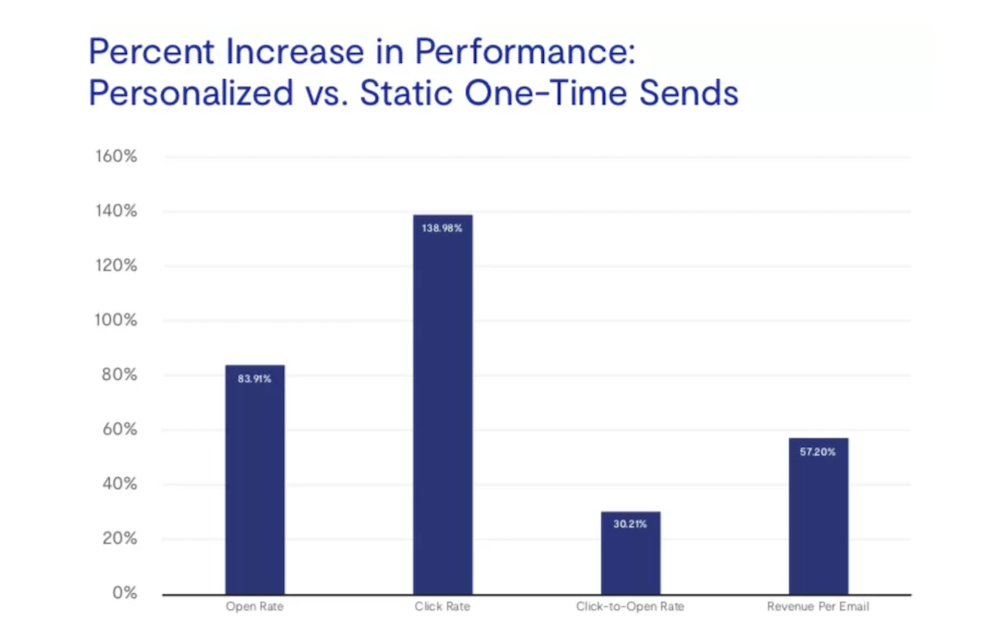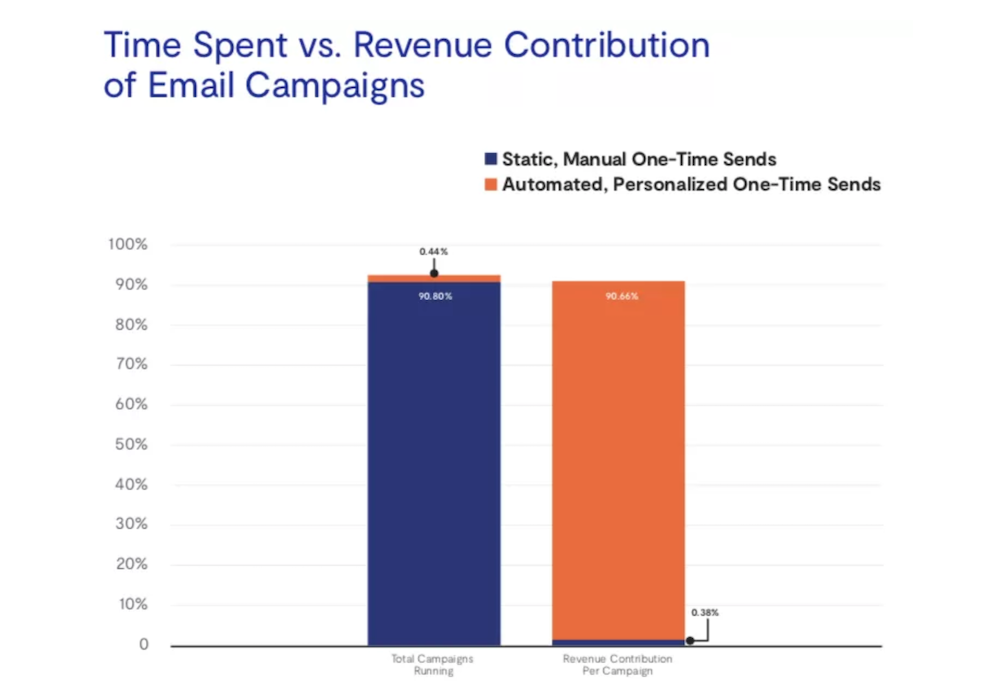The ecommerce marketing emails that perform best, across all measures (think all the traditional metrics: opens, engagement, CTR, conversions) have one thing in common, they are extremely relevant to their recipients, meaning the products, offers and content of the email matter to “that” shopper. The distinction is, not mean the shopper who happened to buy the same item too. That you like the same one item doesn’t make you a clone.
Since the advent of AI ecommerce retailers have been able to achieve relevance through hyper-personalisation or coincidence (e.g. emails that happen to offer products specifically pertinent to that individual).
Traditionally, brands have used audience segments to try to achieve relevance without having to make hard decisions around products, offers, content, priority and timing. Not necessarily through laziness, but more often than not because viability for a return from spending too long on it, makes the ROI prohibitive expensive and unlikely to be achieved. However, this approach is sub-optimal as it leaves money on the table for brands, and leaves most consumers feeling frustrated after receiving content and offers about which they don’t care. Why should I spend my hard money with you, if you’re not interested in me?
Instead, retailers see the biggest returns by focusing on relevance by going beyond simple segmentation to deliver true personalisation. To give this its obvious relevance, we are talking as much as 20-fold the returns you are otherwise used, which is the highest ROI in ecommerce marketing according to the likes of Bain, Forrester and McKinsey.
Segmentation vs. Personalisation: The Difference Matters
Is there a difference between segmentation and personalisation? And does it even matter? Yes and yes.
Segmentation involves dividing your customers into audiences based on broad factors like location or product interest. It usually requires a CRM or CRM-type system, normalised data and attributes tied to a targetable ID, as well as some broad-based understanding of different buyer types that coordinate to different products or offer affinities.
Personalisation involves creating unique experiences for individual customers based on factors like product, content or offer recommendations and priority and timing of your communications. But with the advent of AI, it can also offer the nuances and subtleties captured by navigation, and product review sequence for that individual too. Hyper-personalisation is a tactic to achieve relevance and to achieve a specified business outcome.
Segmentation can be (a manual) way to develop a hyper-personalisation strategy, but segmentation does not equal or even come close to the ROI of hyper-personalisation, and it is phenomenally expensive because it is labour intensive., with people comes frailties, typically errors and omissions.
For example, if you build an audience of people who have bought shirts in the past and send them a static email featuring shirts at a single point in time, that is segmentation. But if you build an audience of people who have bought shirts in the past, send them an email with personalised product recommendations that populate based on their browsing patterns and apply send-time optimisation so the email sends at the best time for each recipient, that is personalisation. This is why hyper-personalisation software, beware of the distinctions between them are considerable, features at the top of available ecommerce hyper-personalisation email software for ecommerce.
While both examples have the same audience, the second example provides each recipient with unique recommendations based on their past behaviour and predicted interests and it ensures they receive the email at a time when they are most likely to engage. As a result, two people in this audience can receive different emails at different times, creating truly personalised experiences.
The Power of Hyper-personalisation in Email Marketing
Consider the case of the athletic retailer that recently ran a test pitting non-personalised emails against emails featuring personalised 1:1 product recommendations. In this head-to-head test, the personalised emails delivered performance gains at every level compared to the segmented emails, including a 57% increase in revenue per email.

These increases in performance stem from the fact that shoppers are more likely to engage with emails when the products featured are relevant to their interests. Over time, this level of personalisation can help brands stand out in crowded inboxes and encourage continued engagement since shoppers will come to expect consistently relevant email content.
While audience segmentation is certainly a good step toward achieving this goal, it’s only a first step. And it typically creates more work, as it requires cutting and managing lists, building out offer and product strategies with merchandising and taking on highly cumbersome optimisation tactics.
Using the example above, simply segmenting your audience to find a group of shoppers interested in shirts helps narrow down which products to promote, but shirts are still a broad category and then require more work with analytics or guesswork. Even segmenting shirts by gender only narrows it down slightly, and it leaves out cross-category shoppers like a mom shopping for her son.
To ensure relevance for every recipient and see significant increases in engagement as a result, you need to get truly personalized at every level. This hyper-personalisation can include any or all of the following:
- Dynamic product recommendations that populate for each individual based on factors like co-purchase patterns, next-best purchase recommendations or predicted affinities
- Dynamic content and offers that populate for each individual based on factors like discount preference, customer lifecycle stage and purchase history
- Dynamic send times to optimise engagement with each individual
Moving Beyond Segmentation to Personalisation
Understanding the power of hyper-personalisation in the future of ecommerce is one thing. Being able to move beyond segmentation to deliver that personalisation is quite another.
Historically, brands have had difficulty scaling personalisation. These challenges typically result from using decades-old email marketing technology that was built to solve decades-old problems (like simply achieving reach via send volume and a basic understanding of your audience). Given how these technologies were built, they make moving beyond segmentation difficult.
However, a new generation of marketing technology has arrived, giving us modern means to solve modern problems (like personalisation). These new solutions support the move from segmentation to personalisation by providing marketers with easy access to customer, behaviour and product data and allowing marketers to activate that data promptly.
One of the best examples of how a modern ESP can support the shift from segmentation to personalisation is the introduction of PPS (predictive personalisation software) to run alongside your ESP. PPS is fully automatic not allowing interference by preventing human involvement.
It allows marketers to use wholly autonomous AI solutions that deliver personalised perpetual sends. It combines the basic idea of a perpetual campaign send (a complete understanding and appreciation of individual consumers, based on that specific customer behaviour, including impressions data.
An IR 100 apparel retailer recently began a campaign alongside its static ESP, manually created one-time sends and saw the full power of hyper-personalisation in action. Although it only made up less than 0.5% of live email campaigns for the retailer, it contributed a phenomenal 90% of campaign revenue.

These numbers don’t just indicate the power of hyper-personalisation, they also highlight the ease of using it — difficulty in achieving this level of personalisation has traditionally been the biggest barrier marketers face in executing personalisation initiatives.
Hyper-personalisation software identifies products with the highest buying propensity for each consumer based on their own unique personal buying history and impressions. And then sends details of those items at the maximum appropriate time to capture additional revenues – the highest ROI in marketing today. Clicks and purchases are made from a perpetual pattern created by that individual, and their interaction with your website.
So sending them details of only those products they are most likely to buy, based on their actions, has a fundamentally positive effect on that individual – they appreciate you knowing them as individuals, and consequently, stay loyal, spend more, return less the list goes on… There is zero segmentation involved and comes toward the top of the highest revenue rates available.





